Sprinkler irrigation is a method of providing rainfall-like irrigation to the crops. Water is distributed through a system of pipes usually by pumping. Spray heads at the outlets distribute the water over the entire soil surface. Sprinklers provide efficient coverage for small to large areas and are suitable for all types of crops. Furthermore, they can be adapted to nearly all irrigable soils since sprinklers are available with a variety of discharge capacities (FAO 1988). However, sprinkler systems can easily clog with the presence of sediment or debris and large systems incur high capital costs.
| In | Out |
|---|---|
Food Products |
Sprinkler Heads
Impact and gear-drive sprinklers are two general types of sprinklers used in lawns, gardens and pastures. They produce moving streams of water and spray nozzles that discharge water on the whole wetted pattern at all times. Impact or gear-drive sprinklers can accommodate only full or part circle application patterns. Since each sprinkler covers a large area (typically 12 m head-to-head spacing), they are used on pastures and larger lawn areas.
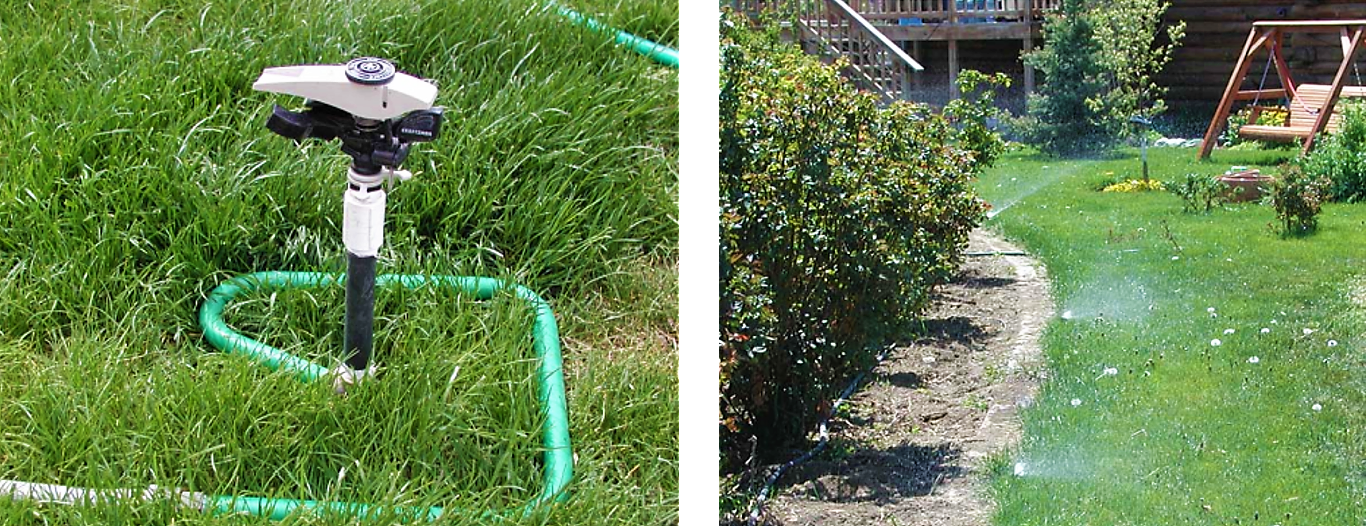
These sprinklers may be used in a solid set configuration where sufficient nozzles are installed to cover all parts of the desired area drawing water from a surface or buried mainline and laterals. Or they can be used in a set-move configuration where lateral lines are operated and then moved at intervals of 12 or 24 hours. Solid set systems cost more to install, but have lower labour requirements and may be automated. The equipment and installation cost per acre of set-move systems is less expensive, but their operation requires more labour, as they cannot be completely automated.

Centre Pivot
This self-propelled sprinkler system rotates around the pivot point and has the lowest labour requirements of the systems considered here. It is constructed using pipes attached to moveable towers. The amount of water applied is controlled by the speed of rotation. Centre pivots can be adjusted to any crop height and are particularly suited for lighter soils. With a computerised control system, the operator is able to program many features for the irrigation process. Furthermore, it is possible to install a corner attachment system (also called “end-gun”) that allows irrigation of corner areas missed out by conventional centre pivot systems.
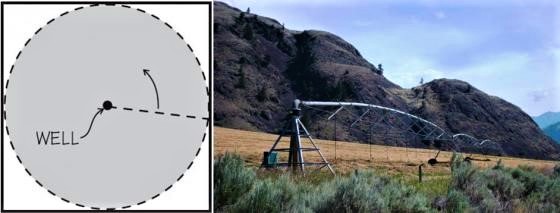
Linear Move
The linear move (also called lateral move) irrigation system is built the same way as a centre pivot; that is moving towers and pipes interconnecting the towers. The main difference is that all the towers move at the same speed and in the same direction. Water is pumped into one of the ends or into the centre. Due to the high capital investment, linear moves are used on high-value crops such as potatoes, vegetables and turf.
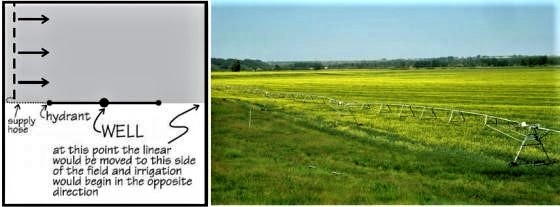
Travelling Big Gun
The travelling big gun system uses a large-capacity nozzle and high pressure to throw water out over the crop as it is pulled through an alley in the field. Travelling big guns come in two main configurations: hard-hose or flexible-hose feed. With the hard-hose system, a hard polyethylene hose is wrapped on a reel mounted on a trailer. The trailer is anchored at the end or centre of the field. The gun is connected to the end of the hose and is pulled towards the trailer. The gun is pulled across the field by the hose winding up on the reel. With the flexible-hose system, the gun is mounted on a four-wheel cart. Water is supplied to the gun by a flexible hose from the main line. A cable winch pulls the cart through the field towards the cart.
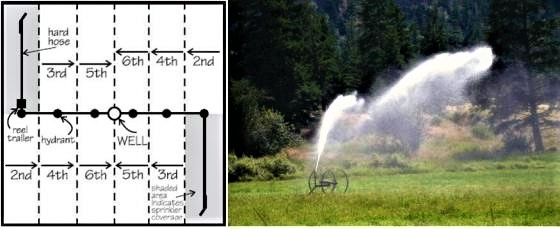
Side Roll
The side roll (also called wheel roll) system consists of a lateral, usually a quarter mile long, mounted on 4 to 10 foot (1 to 3 meters) wheels in diameter and the pipe serving as an axle. When the desired amount of water has been applied to an area, a gasoline engine at the centre is used to move the side roll to the next. The sprinklers are generally mounted on weighted, swivelling connectors so that no matter where the side roll is stopped, the sprinklers will always be on top. This type of system is not recommended for gradients greater than 5 per cent and should be used mainly on flat ground. Side roll systems are adapted only to low growing crops, have medium labour requirements and moderate initial investment.
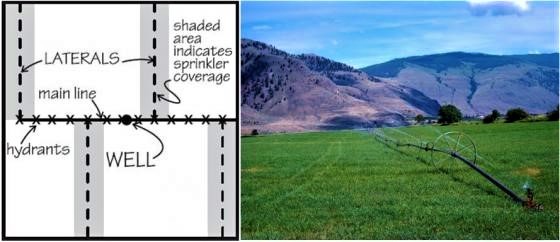
The costs of the different systems vary. Except for small sprinkler equipment for gardening, big systems such as linear move or centre pivot irrigation incur high capital costs. It is important to also consider operation and maintenance costs for these technical and sometimes computer controlled systems.
Depending on the system, expert knowledge is necessary to carry out irrigation. It is important to maintain the whole facility. Motors, water supply pipes/hoses and all mechanical components have to be kept in shape to avoid damage and high repair costs. The operation and maintenance of irrigation equipment for gardens, such as sprinkle or spray heads, is not tricky and thus easy to handle for everyone.
When water quality is very low (e.g. wastewater) and/or solvable fertiliser was added, workers should not stand close to the irrigated field to avoid contact with the water (see also waterborne diseases pathogens and contaminants).
Sprinklers are suited best for sandy soil with high infiltration rates although they are adaptable to most soil types. The average application rate of the sprinklers (in mm/hour) is set lower than the basic infiltration rate of the soil so that surface ponding and runoff can be avoided. Sprinklers are not suitable for soils that easily form a crust or in case of risk of salinisation. Moreover, they can easily clog with the presence of sediments or debris. If sprinkler irrigation is the only method available, then light fine sprays should be used. Sprinklers producing larger water droplets should be avoided (FAO 1988).
Field Irrigation
Irrigation Water Management: Irrigation Methods
This report — the full version only available on-line — shortly explains various irrigation techniques and contains pictures of all the different methods.
FAO (1988): Irrigation Water Management: Irrigation Methods. (= Training manuals - 5 ). Rome: Food and Agriculture Organization of the United Nations (FAO) URL [Accessed: 12.07.2010]Irrigation Systems: Pros and Cons
Equipment Selection and Sizing for Sprinkler and Drip Irrigation
This document describes small-scaled sprinkler and drip systems and also discusses the technical aspects.
NEIBLING, H. ROBBINS, J.A. (n.y): Equipment Selection and Sizing for Sprinkler and Drip Irrigation. Idaho: University of Idaho URL [Accessed: 21.06.2011]Selecting a Sprinkler Irrigation System
This very short paper accurately describes different sprinkler and identifies important aspects for choosing the correct system.
SCHERER, T. (2010): Selecting a Sprinkler Irrigation System. Fargo: North Dakota State University (NDSU) URL [Accessed: 21.06.2011]Small Acreage Irrigation System Selection
How can you decide what irrigation system you need? This paper answers some of the most important “system selection questions”.
BARNHILL, J.V. HILL, R.W. PATTERSON, R. (2009): Small Acreage Irrigation System Selection. Logan: Utah State University URL [Accessed: 20.06.2011]Equipment Selection and Sizing for Sprinkler and Drip Irrigation
This document describes small-scaled sprinkler and drip systems and also discusses the technical aspects.
NEIBLING, H. ROBBINS, J.A. (n.y): Equipment Selection and Sizing for Sprinkler and Drip Irrigation. Idaho: University of Idaho URL [Accessed: 21.06.2011]Selecting a Sprinkler Irrigation System
This very short paper accurately describes different sprinkler and identifies important aspects for choosing the correct system.
SCHERER, T. (2010): Selecting a Sprinkler Irrigation System. Fargo: North Dakota State University (NDSU) URL [Accessed: 21.06.2011]Sprinkler Irrigation
A short description of sprinkler systems and their components.
TNAU (n.y): Sprinkler Irrigation. Coimbatore: TamilNadu Agricultural University URL [Accessed: 21.06.2011]Irrigation Practice and Policy in the Lowlands of the Horn of Africa
The drought of 2011 and the famine that followed in politically instable Somalia highlighted the vulnerability of the lowlands of the Horn of Africa. It is a story revisited with high frequency – 2000, 2005, and 2008. Climate variability is easily mentioned as the main attributing factor. Clearly it is – but there is also extensive land use change, because of the widespread invasion of invasive species (prosopis in particular) and the decimation of natural wood stands for charcoal production (particularly in Somalia). 2011 was a crisis year – but even in a normal years food insecurity is common. In the Afar lowlands in Ethiopia food aid has become part of the livelihoods, with most of the people dependent on it – including reportedly middle class families. There is a growing realization that water resource development – appropriate to the context – has to have a place in addressing food insecurity in the Horn of Africa. This paper focuses on irrigation policy and practice in the arid lowlands of the Horn that have been hit hardest and most frequent in the drought episodes
ALEMEHAYU, T. DEMISSIE, A. LANGAN, S. EVERS, J. (2011): Irrigation Practice and Policy in the Lowlands of the Horn of Africa. Rome: Food and Agriculture Organization of the United Nations (FAO) URL [Accessed: 26.03.2012]The Economics of Sprinkler Irrigation Uniformity: A Case Study of Lettuce on the Swan Coastal plain
This report contains an analysis of the economic incentive to adopt more water efficient sprinkler systems using lettuce as a case study. The economic model draws on several Department of Agriculture studies on the performance of sprinkler systems and yield-water relationships for lettuces on the Swan Coastal Plain.
BRENNAN, D. CALDER, T. (2006): The Economics of Sprinkler Irrigation Uniformity: A Case Study of Lettuce on the Swan Coastal plain. Clayton South: Commonwealth Scientific and Industrial Research Organisation (CSIRO) URL [Accessed: 21.06.2011]Sprinkler irrigation: Profitable or Not
This article discusses the economical side of sprinkler irrigation.
HARRIS, G. (2007): Sprinkler irrigation: Profitable or Not. Toowoomba: The Australian Cottongrower URL [Accessed: 21.06.2011]Managing Energy-irrigation Nexus in India
The supply of unmetered power to farmers has led to excessive usage and consequently, declining water levels. This paper examines the solutions being implemented by state governments to address the inefficient use of energy and irrigation. It concludes that 'textbook solutions' are not feasible in the current social setting, and recommends negotiable and politically acceptable solutions. This data-rich paper also presents statistics on current groundwater and energy use.
MUKHERJI, A. SHAH, T. GIORDANO, M. (2012): Managing Energy-irrigation Nexus in India. A typology of State interventions. (= Water Policy Research Highlight , 36 ). Gujarat, India: IWMI-Tata Water Policy Program URL [Accessed: 15.01.2013]Potential and Challenges in Up-scaling Micro-irrigation in India
This paper aims to fill a research gap in India by focusing on adoption patterns of micro irrigation and the economic impacts on farm households.This study is based on primary and secondary data collected from nine states. It seeks to establish a relationship between landholding size, area under micro-irrigation, and net benefits. Farmers' suggestions for making micro irrigation more accessible are also noted.
PALANISAMI, K. RAMAN, S. (2012): Potential and Challenges in Up-scaling Micro-irrigation in India. Experiences from Nine States . (= Water Policy Research Highlight , 20 ). Gujarat, India: IWMI-Tata Water Policy Program URL [Accessed: 15.01.2013]Solar-Powered Pump Irrigation and India’s Groundwater Economy
The poor reliability of electricity and the falling costs of solar technology are making solar pumps increasingly attractive. This paper explores this phenomenon and suggests that this is not merely an energy issue but also a water issue. Steep fixed rates and low operational costs make it ideal for service providers. This will lead to increased exploitation of groundwater, which might prove to be damaging in already over-exploited areas.The paper also explores alternative subsidy designs.
SHAH, T. KISHORE, A. (2012): Solar-Powered Pump Irrigation and India’s Groundwater Economy. A Preliminary Discussion of Opportunities and Threats. (= Water Policy Research Highlight , 26 ). Gujarat, India: IWMI-Tata Water Policy Program URL [Accessed: 15.01.2013]Solar irrigation pumps: The Rajasthan experience
In 2012, the Rajasthan government initiated a 86% subsidy for installing irrigation pumps the run on solar energy. This was designed for selected districts with a predetermined quota. This paper examines the method of administering subsidy, the demand for pumps and administrative issues including determining eligivility of both farmers and supply firms, and the logistics of delivering these pumps.The performance of these pumps, as also the other incidental benefits to farmers are discussed in detail. The paper remarks on the use of these pumps to draw groundwater rather than water from surface ponds. It recommends that drip irrigation be made a pre-requisite for subsidy in order to minimize its impact on the already-stressed groundwater in Rajasthan.
TEWARI, N.P. (2012): Solar irrigation pumps: The Rajasthan experience. (= Water Policy Research Highlight , 35 ). Gujarat, India: IWMI-Tata Water Policy Program URL [Accessed: 15.01.2013]International Development Enterprises (IDE)
The website of International Development Enterprises (IDE) contains many (technology-)documents, photos and information about the water and agricultural section in developing countries.



